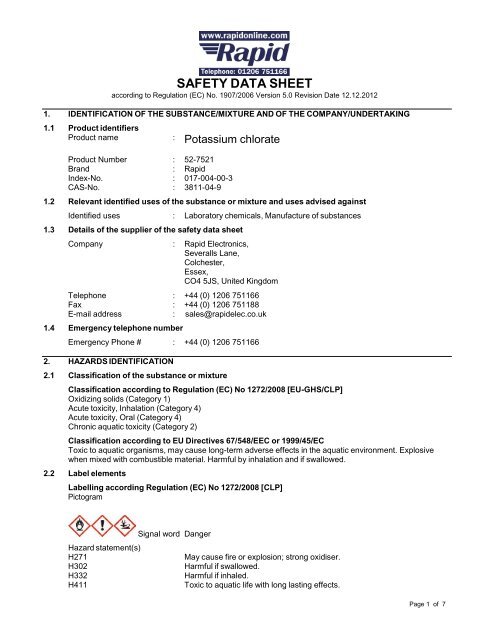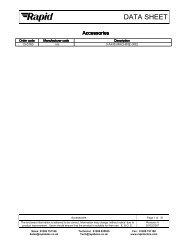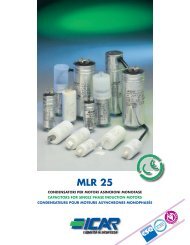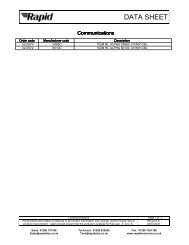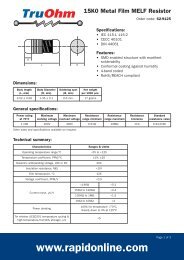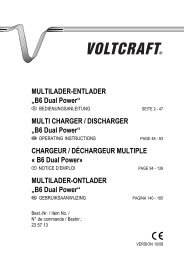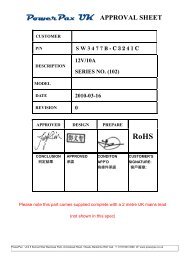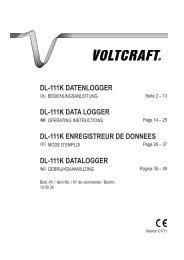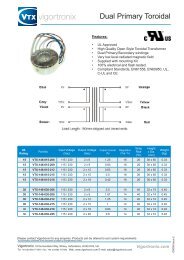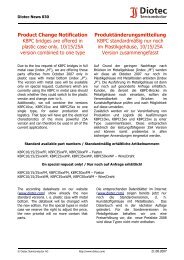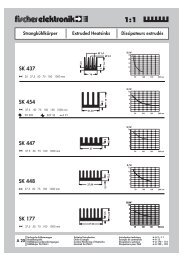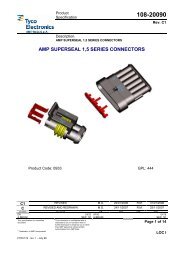Safety Data Sheet - Rapid Electronics
Safety Data Sheet - Rapid Electronics
Safety Data Sheet - Rapid Electronics
You also want an ePaper? Increase the reach of your titles
YUMPU automatically turns print PDFs into web optimized ePapers that Google loves.
SAFETY DATA SHEET<br />
according to Regulation (EC) No. 1907/2006 Version 5.0 Revision Date 12.12.2012<br />
1. IDENTIFICATION OF THE SUBSTANCE/MIXTURE AND OF THE COMPANY/UNDERTAKING<br />
1.1 Product identifiers<br />
Product name : Potassium chlorate<br />
Product Number : 52-7521<br />
Brand : <strong>Rapid</strong><br />
Index-No. : 017-004-00-3<br />
CAS-No. : 3811-04-9<br />
1.2 Relevant identified uses of the substance or mixture and uses advised against<br />
Identified uses : Laboratory chemicals, Manufacture of substances<br />
1.3 Details of the supplier of the safety data sheet<br />
Company : <strong>Rapid</strong> <strong>Electronics</strong>,<br />
Severalls Lane,<br />
Colchester,<br />
Essex,<br />
CO4 5JS, United Kingdom<br />
Telephone : +44 (0) 1206 751166<br />
Fax : +44 (0) 1206 751188<br />
E-mail address : sales@rapidelec.co.uk<br />
1.4 Emergency telephone number<br />
Emergency Phone # : +44 (0) 1206 751166<br />
2. HAZARDS IDENTIFICATION<br />
2.1 Classification of the substance or mixture<br />
Classification according to Regulation (EC) No 1272/2008 [EU-GHS/CLP]<br />
Oxidizing solids (Category 1)<br />
Acute toxicity, Inhalation (Category 4)<br />
Acute toxicity, Oral (Category 4)<br />
Chronic aquatic toxicity (Category 2)<br />
Classification according to EU Directives 67/548/EEC or 1999/45/EC<br />
Toxic to aquatic organisms, may cause long-term adverse effects in the aquatic environment. Explosive<br />
when mixed with combustible material. Harmful by inhalation and if swallowed.<br />
2.2 Label elements<br />
Labelling according Regulation (EC) No 1272/2008 [CLP]<br />
Pictogram<br />
Signal word Danger<br />
Hazard statement(s)<br />
H271<br />
May cause fire or explosion; strong oxidiser.<br />
H302<br />
Harmful if swallowed.<br />
H332<br />
Harmful if inhaled.<br />
H411<br />
Toxic to aquatic life with long lasting effects.<br />
Page 1 of 7
Precautionary statement(s)<br />
P220<br />
P273<br />
Supplemental Hazard<br />
Statements<br />
Keep/Store away from clothing/ combustible materials.<br />
Avoid release to the environment.<br />
none<br />
According to European Directive 67/548/EEC as amended.<br />
Hazard symbol(s)<br />
R-phrase(s)<br />
R 9<br />
R20/22<br />
R51/53<br />
S-phrase(s)<br />
S13<br />
S16<br />
S27<br />
S61<br />
2.3 Other hazards - none<br />
Explosive when mixed with combustible material.<br />
Harmful by inhalation and if swallowed.<br />
Toxic to aquatic organisms, may cause long-term adverse effects in the<br />
aquatic environment.<br />
Keep away from food, drink and animal feedingstuffs.<br />
Keep away from sources of ignition - No smoking.<br />
Take off immediately all contaminated clothing.<br />
Avoid release to the environment. Refer to special instructions/ <strong>Safety</strong><br />
data sheets.<br />
3. COMPOSITION/INFORMATION ON INGREDIENTS<br />
3.1 Substances<br />
Formula : ClKO 3<br />
Molecular Weight : 122.55 g/mol<br />
Component<br />
Potassium chlorate<br />
CAS-No. 3811-04-9<br />
EC-No. 223-289-7<br />
Index-No. 017-004-00-3<br />
Concentration<br />
-<br />
4. FIRST AID MEASURES<br />
4.1 Description of first aid measures<br />
General advice<br />
Consult a physician. Show this safety data sheet to the doctor in attendance.<br />
If inhaled<br />
If breathed in, move person into fresh air. If not breathing, give artificial respiration. Consult a physician.<br />
In case of skin contact<br />
Wash off with soap and plenty of water. Consult a physician.<br />
In case of eye contact<br />
Rinse thoroughly with plenty of water for at least 15 minutes and consult a physician.<br />
If swallowed<br />
Never give anything by mouth to an unconscious person. Rinse mouth with water. Consult a physician.<br />
4.2 Most important symptoms and effects, both acute and delayed<br />
anemia, Absorption into the body leads to the formation of methemoglobin which in sufficient concentration<br />
causes cyanosis. Onset may be delayed 2 to 4 hours or longer., Nausea, Vomiting, Diarrhoea,<br />
Hemorrhage., Liver, Convulsions<br />
4.3 Indication of any immediate medical attention and special treatment needed<br />
no data available<br />
Page 2 of 7
5. FIREFIGHTING MEASURES<br />
5.1 Extinguishing media<br />
Suitable extinguishing media<br />
Use water spray, alcohol-resistant foam, dry chemical or carbon dioxide.<br />
5.2 Special hazards arising from the substance or mixture<br />
Hydrogen chloride gas, Potassium oxides<br />
5.3 Advice for firefighters<br />
Wear self contained breathing apparatus for fire fighting if necessary.<br />
5.4 Further information<br />
Use water spray to cool unopened containers.<br />
6. ACCIDENTAL RELEASE MEASURES<br />
6.1 Personal precautions, protective equipment and emergency procedures<br />
Use personal protective equipment. Avoid dust formation. Avoid breathing vapors, mist or gas. Ensure<br />
adequate ventilation. Evacuate personnel to safe areas. Avoid breathing dust.<br />
6.2 Environmental precautions<br />
Prevent further leakage or spillage if safe to do so. Do not let product enter drains. Discharge into the<br />
environment must be avoided.<br />
6.3 Methods and materials for containment and cleaning up<br />
Sweep up and shovel. Contain spillage, and then collect with an electrically protected vacuum cleaner or<br />
by wet-brushing and place in container for disposal according to local regulations (see section 13). Keep<br />
in suitable, closed containers for disposal.<br />
6.4 Reference to other sections<br />
For disposal see section 13.<br />
7. HANDLING AND STORAGE<br />
7.1 Precautions for safe handling<br />
Avoid contact with skin and eyes. Avoid formation of dust and aerosols.<br />
Provide appropriate exhaust ventilation at places where dust is formed.Keep away from sources of ignition<br />
- No smoking.<br />
7.2 Conditions for safe storage, including any incompatibilities<br />
Store in cool place. Keep container tightly closed in a dry and well-ventilated place.<br />
7.3 Specific end use(s)<br />
no data available<br />
8. EXPOSURE CONTROLS/PERSONAL PROTECTION<br />
8.1 Control parameters<br />
Components with workplace control parameters<br />
Contains no substances with occupational exposure limit values.<br />
8.2 Exposure controls<br />
Appropriate engineering controls<br />
Handle in accordance with good industrial hygiene and safety practice. Wash hands before breaks and<br />
at the end of workday.<br />
Personal protective equipment<br />
Eye/face protection<br />
<strong>Safety</strong> glasses with side-shields conforming to EN166 Use equipment for eye protection tested<br />
and approved under appropriate government standards such as NIOSH (US) or EN 166(EU).<br />
Skin protection<br />
Handle with gloves. Gloves must be inspected prior to use. Use proper glove removal technique<br />
(without touching glove's outer surface) to avoid skin contact with this product. Dispose of<br />
Page 3 of 7
contaminated gloves after use in accordance with applicable laws and good laboratory practices.<br />
Wash and dry hands.<br />
The selected protective gloves have to satisfy the specifications of EU Directive 89/686/EEC and<br />
the standard EN 374 derived from it.<br />
Full contact<br />
Material: Nitrile rubber<br />
Minimum layer thickness: 0.11 mm<br />
Break through time: 480 min<br />
Material tested:Dermatril® (KCL 740 / Aldrich Z677272, Size M)<br />
Splash protection<br />
Material: Nitrile rubber<br />
Minimum layer thickness: 0.11 mm<br />
Break through time: 480 min<br />
Material tested:Dermatril® (KCL 740 / Aldrich Z677272, Size M)<br />
data source: KCL GmbH, D-36124 Eichenzell, phone +49 (0)6659 87300, e-mail sales@kcl.de,<br />
test method: EN374<br />
If used in solution, or mixed with other substances, and under conditions which differ from EN 374,<br />
contact the supplier of the CE approved gloves. This recommendation is advisory only and must<br />
be evaluated by an Industrial Hygienist familiar with the specific situation of anticipated use by our<br />
customers. It should not be construed as offering an approval for any specific use scenario.<br />
Body Protection<br />
Complete suit protecting against chemicals, The type of protective equipment must be selected<br />
according to the concentration and amount of the dangerous substance at the specific workplace.<br />
Respiratory protection<br />
Where risk assessment shows air-purifying respirators are appropriate use a full-face particle<br />
respirator type N100 (US) or type P3 (EN 143) respirator cartridges as a backup to engineering<br />
controls. If the respirator is the sole means of protection, use a full-face supplied air respirator. Use<br />
respirators and components tested and approved under appropriate government standards such<br />
as NIOSH (US) or CEN (EU).<br />
9. PHYSICAL AND CHEMICAL PROPERTIES<br />
9.1 Information on basic physical and chemical properties<br />
a) Appearance Form: crystalline<br />
Colour: white<br />
b) Odour no data available<br />
c) Odour Threshold no data available<br />
d) pH 5.0 - 6.5 at 61.3 g/l at 25 °C<br />
e) Melting point/freezing<br />
point<br />
f) Initial boiling point and<br />
boiling range<br />
Melting point/range: 356 °C - lit.<br />
no data available<br />
g) Flash point not applicable<br />
h) Evaporation rate no data available<br />
i) Flammability (solid, gas) no data available<br />
j) Upper/lower<br />
flammability or<br />
explosive limits<br />
no data available<br />
k) Vapour pressure no data available<br />
l) Vapour density no data available<br />
m) Relative density 2.320 g/cm3<br />
n) Water solubility ca.61.3 g/l at 20 °C<br />
Page 4 of 7
o) Partition coefficient: n-<br />
octanol/water<br />
p) Auto-ignition<br />
temperature<br />
q) Decomposition<br />
temperature<br />
no data available<br />
no data available<br />
no data available<br />
r) Viscosity no data available<br />
s) Explosive properties no data available<br />
t) Oxidizing properties no data available<br />
9.2 Other safety information<br />
no data available<br />
10. STABILITY AND REACTIVITY<br />
10.1 Reactivity<br />
no data available<br />
10.2 Chemical stability<br />
no data available<br />
10.3 Possibility of hazardous reactions<br />
no data available<br />
10.4 Conditions to avoid<br />
no data available<br />
10.5 Incompatible materials<br />
Strong reducing agents, Powdered metals, Strong acids, Alcohols, Organic materials<br />
10.6 Hazardous decomposition products<br />
Other decomposition products - no data available<br />
11. TOXICOLOGICAL INFORMATION<br />
11.1 Information on toxicological effects<br />
Acute toxicity<br />
LD50 Oral - rat - 1,870 mg/kg<br />
LD50 Dermal - rabbit - > 2,000 mg/kg<br />
Skin corrosion/irritation<br />
Skin - rabbit - Mild skin irritation<br />
Serious eye damage/eye irritation<br />
Eyes - rabbit - Mild eye irritation<br />
Respiratory or skin sensitization<br />
no data available<br />
Germ cell mutagenicity<br />
no data available<br />
Carcinogenicity<br />
IARC:<br />
Reproductive toxicity<br />
no data available<br />
No component of this product present at levels greater than or equal to 0.1% is identified as<br />
probable, possible or confirmed human carcinogen by IARC.<br />
Specific target organ toxicity - single exposure<br />
no data available<br />
Specific target organ toxicity - repeated exposure<br />
no data available<br />
Page 5 of 7
Aspiration hazard<br />
no data available<br />
Potential health effects<br />
Inhalation<br />
Ingestion<br />
Skin<br />
Eyes<br />
Harmful if inhaled. May cause respiratory tract irritation.<br />
Harmful if swallowed.<br />
May be harmful if absorbed through skin. May cause skin irritation.<br />
Causes eye irritation.<br />
Signs and Symptoms of Exposure<br />
anemia, Absorption into the body leads to the formation of methemoglobin which in sufficient concentration<br />
causes cyanosis. Onset may be delayed 2 to 4 hours or longer., Nausea, Vomiting, Diarrhoea,<br />
Hemorrhage., Liver, Convulsions<br />
Additional Information<br />
RTECS: FO0350000<br />
12. ECOLOGICAL INFORMATION<br />
12.1 Toxicity<br />
Toxicity to fish<br />
Toxicity to daphnia and<br />
other aquatic<br />
invertebrates<br />
12.2 Persistence and degradability<br />
no data available<br />
12.3 Bioaccumulative potential<br />
no data available<br />
12.4 Mobility in soil<br />
no data available<br />
12.5 Results of PBT and vPvB assessment<br />
no data available<br />
12.6 Other adverse effects<br />
Toxic to aquatic life.<br />
13. DISPOSAL CONSIDERATIONS<br />
13.1 Waste treatment methods<br />
LC50 - Oncorhynchus mykiss (rainbow trout) - 1.750 mg/l - 96.0 h<br />
EC50 - Daphnia magna (Water flea) - 1,093 mg/l - 24 h<br />
Product<br />
Burn in a chemical incinerator equipped with an afterburner and scrubber but exert extra care in igniting<br />
as this material is highly flammable. Offer surplus and non-recyclable solutions to a licensed disposal<br />
company.<br />
Contaminated packaging<br />
Dispose of as unused product.<br />
14. TRANSPORT INFORMATION<br />
14.1 UN number<br />
ADR/RID: 1485 IMDG: 1485 IATA: 1485<br />
14.2 UN proper shipping name<br />
ADR/RID: POTASSIUM CHLORATE<br />
IMDG: POTASSIUM CHLORATE<br />
IATA: Potassium chlorate<br />
14.3 Transport hazard class(es)<br />
ADR/RID: 5.1 IMDG: 5.1 IATA: 5.1<br />
14.4 Packaging group<br />
ADR/RID: II IMDG: II IATA: II<br />
Page 6 of 7
14.5 Environmental hazards<br />
ADR/RID: yes IMDG Marine Pollutant: yes IATA: no<br />
14.6 Special precautions for user<br />
no data available<br />
15. REGULATORY INFORMATION<br />
This safety datasheet complies with the requirements of Regulation (EC) No. 1907/2006.<br />
15.1 <strong>Safety</strong>, health and environmental regulations/legislation specific for the substance or mixture<br />
no data available<br />
15.2 Chemical <strong>Safety</strong> Assessment<br />
no data available<br />
16. OTHER INFORMATION<br />
Further information<br />
The above information is believed to be correct but does not purport to be all inclusive and shall be<br />
used only as a guide. The information in this document is based on the present state of our knowledge<br />
and is applicable to the product with regard to appropriate safety precautions. It does not represent any<br />
guarantee of the properties of the product.<br />
Page 7 of 7


